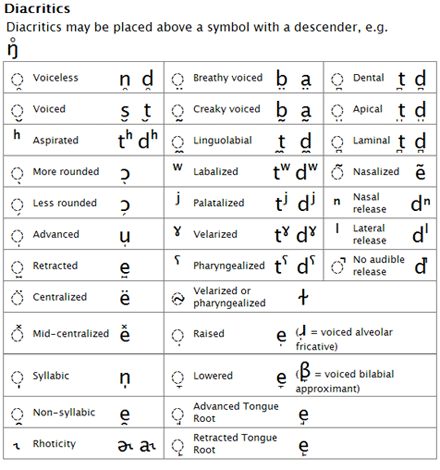

Also note how 4th tone is the checked version of 7th tone, hence when 8th tone undergoes sandhi to 4th tone, it also bears the same diacritic, plus sign below. Note how none of 7th tones are affected by tone sandhi here, so they all have the same diacritic, plus sign below. 物件 mih8-kiann7, 8th tone becomes 3rd tone before glottal stop -h, which is a low falling tone (in Taipei), hence grave accent below.内 lai7 and 有 u7 are both 7th tone and do not undergo tone sandhi here, hence remain in 7th tone (mid tone), hence plus sign below.Note how 我 and 睭 are both high level tone, and so both bear a macron above. 目睭 bak8-tsiu1, 8th tone becomes 4th tone (mid/low stopped), hence plus sign below.我个 gua2-e5, 2nd tone becomes 1st tone (high level tone), hence macron above.They do differ from the Tâi-lô romanisation of the same sentence, and that is by design: Tâi-lô shows original tones as the words would have been pre-sandhi, whilst the "Pronunciation" and "Phonics" lines show tones as they are realised and heard, post-sandhi. The diacritics around the vowels are indeed the tones, and they are fairly accurate for any mainstream Taiwanese pronunciation. (My personal mode of speech tends to pre-nasalise the plosive pretty heavily too.)Īdditional side note: The pronunciation line is the Glossika Universal Pinyin system. Minor note: I disagree with 目睭's phonics line - that initial bilabial plosive is voiced, which would be /b/ not /p =/. The written features you mention for Wiktionary's IPA, such as the overline tie for /t͡ɕ/ and the combining left angle above for /k̚/ for unreleased final stops, do not matter for a broad phonemic transcription in Min Nan / Hokkien: affricates do not need to be distinguished from released "clusters" (compare this situation with Polish) all final stops are unreleased. the tones are way more intuitive than the IPA's tone diacritics (although I personally prefer tone "letters", which are official IPA now).superscript ⁿ is nasal release (a consonantal feature) in IPA, but here it is used for nasalisation of vowels.superscript "=" for unaspirated plosives is from extended IPA.There are quite a few non-standard IPA features in the "phonics" line: As far as I understand, the superscript = means lack of aspiration and the superscript n means nasalization, but the other ones I wasn't able to figure out. Probably this is some standard thing, but I don't have much experience with IPA. For example, "gua" comes with an overline in the IPA line, but at the same time it has the second tone (see the "Typing" line), and the second tone is denoted by a prime `, and not by overline.) What do they mean? (I don't think they refer to tones. t͡ɕʰ (with this "hat") or the stop k̚ - maybe Glossika uses a different notation? In the above example bak8 should have a stop k.).Īlso, some letters have other kinds of primes and overlines. And vice versa, some of the symbols from the article never appear on Glossika (e.g. What do those mean? I don't see them in this article on Taiwanese Hokkien IPA. The IPA line has "pluses" (+) and some kind of primes underneath some letters. (The "Typing" line is the Tâi-lô romanization I don't know where the "Pronunciation" line comes from, it is not any standard romanization of Taiwanese Hokkien.) However, in writing a rule, it means "0 or 1 occurrences of", so "a→b/_(c)d" means "a becomes b when followed by d with zero or one occurrence of c intervening".Here is an example of a sentence from the Glossika course in Taiwanese Hokkien: In a list of phonemes, it implies that there is something marginal about the item in parentheses, for example one might list "(x)" in a phoneme chart of English, since there are a few words which some people pronouns with the velar fricative (Bach, loch, Chanukah, chutzpah, Khalil). If the realization of a sound was "anything between and ", you would have to say that in words. There is no notation for talking of ranges of realization that are finer-grained than two similar transcriptions. Whilst you press and hold the alt key, press the alt code.
#E with tilde in ipa code
It does not mean "some value intermediate between", it means "either this value or that value". E with tilde quick guide ( or ) To type e with tilde on the keyboard for Microsoft Word, press and hold the alt key, and using the numeric keypad, press the character alt code (7869 for small letter and 7868 for capital letter ). Square brackets canonically refer to phonetic values, so would be that the thing in question (perhaps phonemic /dz/) is realised either as phonetic or as phonetic ). It also can be used to refer to contextual variation, for example "The plural suffix, s ~ z ~ ɨz.". The symbol "~" typically means "alternates with", for example "a~æ" could be that either a or æ would be possible in a given context (i.e. Not all symbols used in phonological and phonetic descriptions are letters of the IPA.


 0 kommentar(er)
0 kommentar(er)
